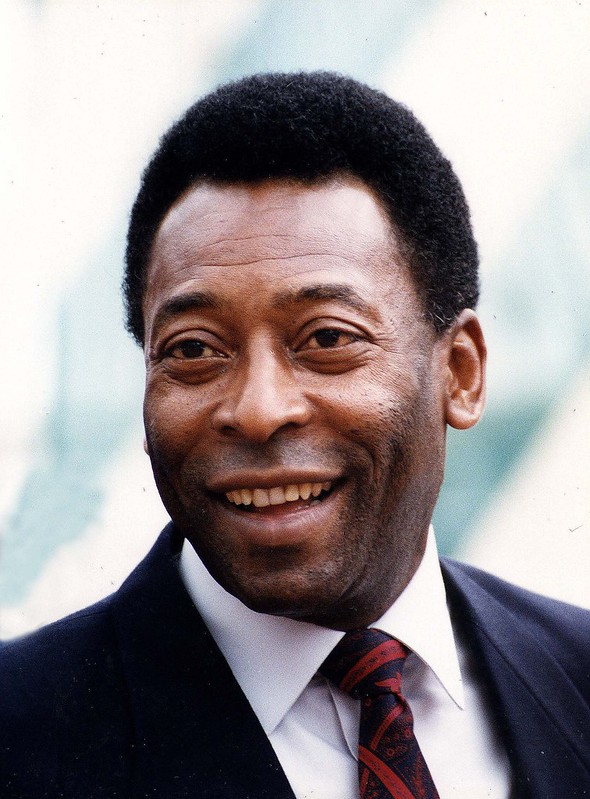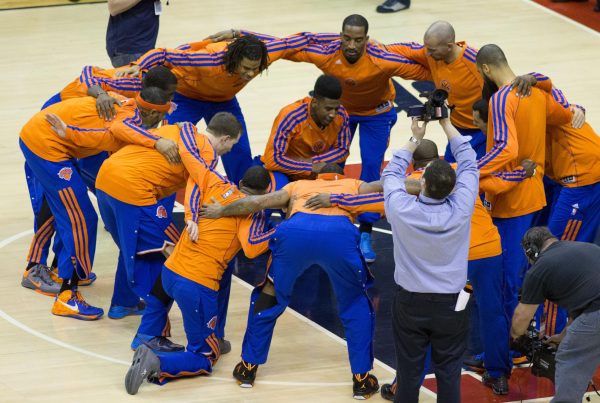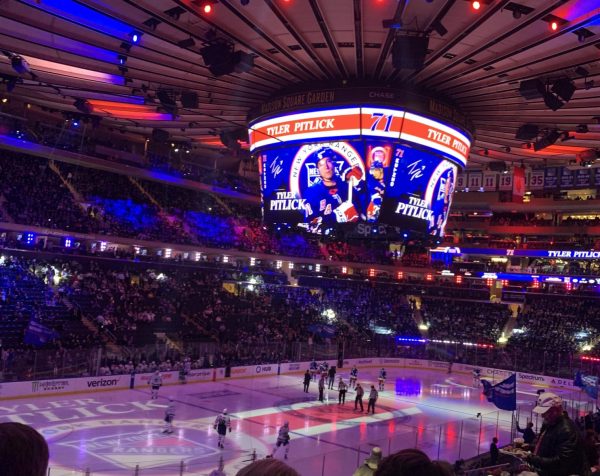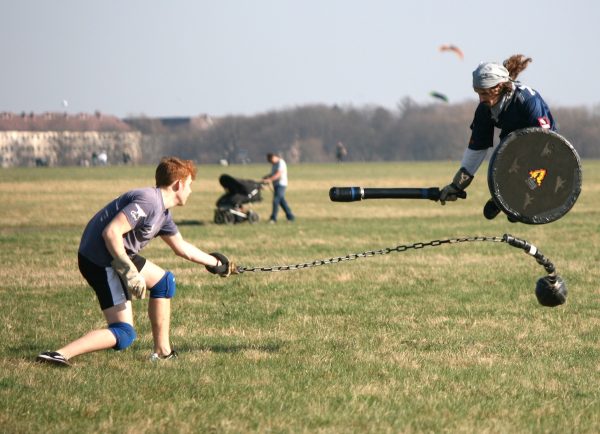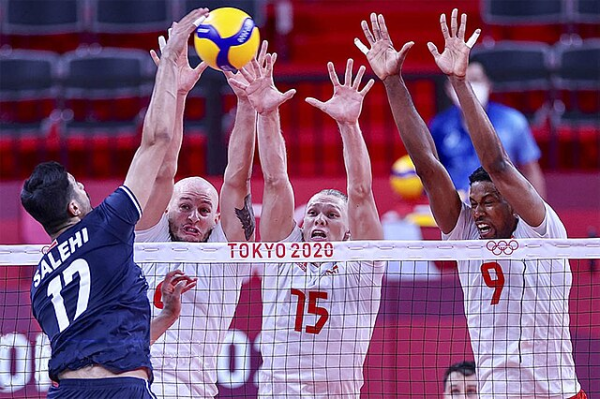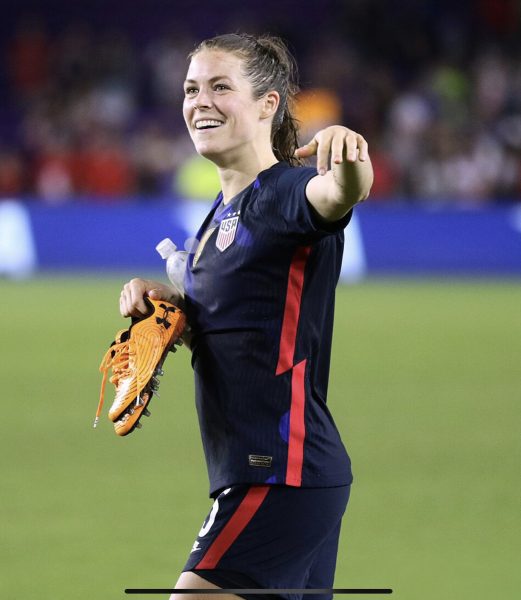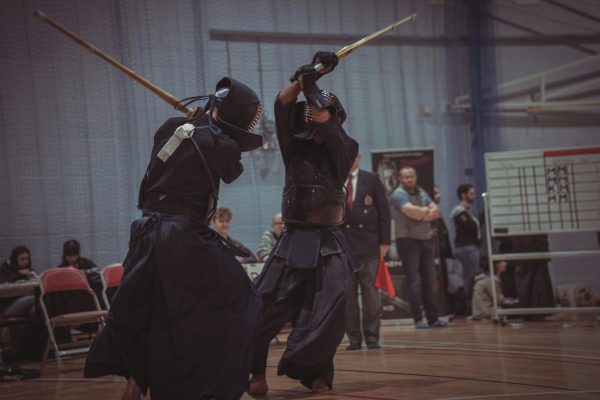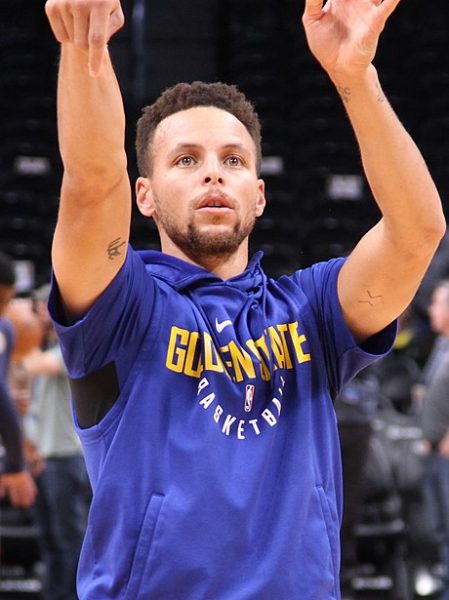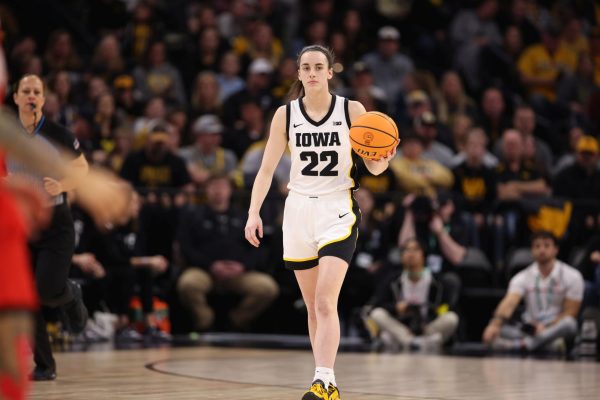Pelé: The Legacy of O Rei
On December 29th, 2022, the Brazilian soccer legend, Pelé passed away. Immediately following this, millions of soccer-lovers around the world, including some of the biggest superstar players in the modern era, sent their regards to the family and honored his career. Here is a summary of Pelé’s distinguished World Cup career.
John Mathew Smith from Laurel Maryland, USA, CC BY-SA 2.0
Pelé passed away on the 29th of December, 2022. “He is one of the all-time greats, a 3-time World Cup winner with Brazil,” said Jack Goss ’23.
Dazzling up and down the pitch and even through defenders as the commentators lose their voice, he scores yet another goal.
His young friends move the gigantic cards, looking to replace the one that has a huge “2” imprinted on its forefront with another that has a huge “3” instead; the away team, called “the shoeless ones,” are now leading by three whole goals, all within the first eight minutes of the match.
A considerable portion of the team’s success could be attributed to the then thirteen year old Edson Arantes do Nascimento, playing in the streets of Bauru, São Paulo without the comfort of fútbol cleats. Yet, he would only have to wait three more years to anticipate a much broader audience: the entire nation of Brazil.
Born Edson Arantes do Nascimento, his Brazilian friends later designated another nickname to him — one that they felt was more befitting in terms of the way he played soccer: Pelé. Ironically, the rationale behind this nickname, given to a man who would go on to win three World Cups for his country, was based on his inability to kick a soccer ball straight during his younger years. Even though the name is incorrect in every aspect, it became one of the most widely recognized names not only in soccer, but throughout the entire world.
Pelé, whom many consider to be “O Rei” (the king), unfortunately passed away on December 29th, 2022. Regardless, his lifetime of influence on the pitch carries on and will continue to carry on for several generations.
When asked who is Pelé? Samad Hamid ’26 said, “Pelé is aguably one of the greatest players in the history of the sport of soccer. He won 3 World Cups and revolutionized the sport. Many of the skill moves players do today, Pelé did first.”
Here is a summary of the World Cup Career of the only soccer player in history to win it thrice.
Pelé signed for Santos FC in 1956 at the age of 15, becoming the youngest individual to become a professional footballer in Brazil. Earning a position in the starting lineup for Santos one year later as a left forward, Pelé quickly became the top scorer in the top Brazilian league, Compeonato Brasileiro (BRA 1).
In 1958, Pelé, along with his key teammates such as Nílton dos Santos and José Macia, led Santos FC to their fourth claim of the Campeonato Paulista (sometimes called Paulistão), which is granted to the winner of the best soccer teams in the state of Sao Paulo, Brazil. Scoring 58 goals in that tournament, Pelé still remains the top-scorer of the tournament to this day.
Then, near the middle of that year, Pelé received a special phone call providing an offer that every soccer player dreams to receive: an invitation to play in the national team. It was perhaps his incredible performance throughout the Campeonato Paulista tournament in addition to the 1958 season that led to this culmination of being in the Brazilian national squad among the likes of Manuel Francisco dos Santos (more commonly known as Garrincha), Waldyr Pereira (nicknamed as Didi), Edvaldo Izidio Neto (sometimes called as Vava), and more: Pelé was no longer solely in the stage of Sao Paulo that he had been getting accustomed to for two years as his career advanced with his undertaking of an international scale with Brazil in the 1958 World Cup hosted by Sweden.
Headlines spotted included, “A Teenager in the Team Sheets for the World-Renowned Brazilian Squad!” and “Can This Kid Perform?”
Pelé’s world cup career officially began during Brazil’s third group stage match against the Soviet Union. Spectators were awed as Pelé exerted an intense influence on the pitch since he completed several successful dribbles and even assisted towards a goal that Vava secured, winning the hearts of Brazilians, his personal fans, and especially his coach Vicente Ítalo Feola, who decided to place Pelé in the starting line-up for the upcoming elimination matches of the tournament.
Pelé’s next appearance was in the starting position for the quarter finals against Wales. Pelé led his fellow Brazilian team-mates through as the only scorer of the match when in the 66th minute of the match, Pelé broke Welsh hearts: Brazil won 1 – 0 against Wales to move on to the semi finals of the biggest soccer tournament in the world.
With his starting position as the Brazilian number #10, the jersey which many consider to be that of the team’s essential player, Pelé looked onto the next match. Brazil’s semi final competition was France, a top-nine soccer nation as ranked by the International Federation of Association Football (FIFA) and a nation that many soccer fans consider to be the fierce rivals of Brazil in terms of skill and talent. The match was largely even for the first 45 minutes prior to half-time as both teams equally opened the scoring within the first ten minutes of the match; Vava scored in the 2nd minute of the match but the Frenchman Just Fontaine tied the game back up by scoring in the 9th minute. In addition, Didi scored for Brazil in the 39th minute, giving his team a slight 2 – 1 edge when the second-half of the match started. However, Pelé drove the final nail in the coffin of France’s potential comeback as he consecutively scored three goals: a hat-trick for the youngster to make it 5 – 1 for Brazil in the semi finals of the biggest soccer tournament in the world.
He became a national hero, and many dubbed him the wonderkid that would provide Brazil with their first World Cup trophy. However, the Finals Match was still daunting. The hosts of the tournament, Sweden, had shown consistently promising results all throughout the tournament and they were to be the final adversaries of the Brazilian squad. Was there any limit to the boy’s talent? People had yet to find out.
On the 29th of June, 1958, Pelé made history, becoming the only teenager to ever be involved in, score, and win a World Cup Finals Match: a record that stood for over 60 years. On the shoulders of his team’s goalkeeper Gilmar Dos Santos Neves, Pelé wept, as he had substantially helped in bringing Brazil’s long-awaited World Cup home.
Pelé and the World Cup would return to Brazil together and euphoria erupted upon their arrival. O rei had already ensured and cemented his position onto the global stage for generations to come, but his legacy did not end there.
Despite receiving multiple offers from some of the biggest clubs in the world, Pelé remained at Santos FC, becoming Brazil’s “national treasure.” Rather than being a genuine honorary delegation that the Brazilian government, including President Janio Quandros, provided, Pelé’s status as a piece of Brazilian “national treasure” inevitably contained ulterior motives.
Offers from European clubs piled on the desks of Santo FC’s management team as they frantically rejected a vast majority of such letters, striving to keep Pelé in their team. In addition to Santos FC, several Brazilians fans and entrepreneurs associated with the top Brazilian league Compeonato Brasileiro hoped to have Pelé remain in the Brazilian stage. President Quadros, desperately seeking popularity due to the upcoming election season, implemented a bill that he believed to be in the best interest of Brazil’s populace: designating Pelé as a “national treasure” such as to prevent his departure from the Brazilian league to another non-domestic club.
However, Pelé’s limitation of being unable to prove himself in different leagues, especially European ones, did not hinder his ability to continuously defy expectations.
These expectations were high for Brazil, and especially the #10 forward attacker Pelé, ahead of the 1962 World Cup, hosted by Chile. The Brazilian squad’s debut game in the tournament was against Mexico. Mário Zagallo, assisted by Pelé, opened the scoring in the 56th minute with none other than Pelé again contributing to their lead following the 73rd minute: Brazil won 2 goals to Mexico’s 0.
The opposition for the next group stage match for Brazil were the runners-up of the Italy 1934 World Cup, Czechoslovakia. Pelé was involved immensely and this game against Czechoslovakia in the group stage proved to be crucial despite ending in a 0 goals to 0 draw – Pelé suffered a tear in a thigh muscle after attempting a long shot with his non-dominant foot. Fans and other teams keenly observed as they anticipated the star player to be pulled out of the rest of the tournament. Despite claiming to play in the upcoming elimination matches, Pelé was unfortunately forced to sit out the rest of the tournament after he suffered another groin-related injury during practice.
Brazilian Coach Aymore Moreira had to alter his line-up with Pelé unable to be in the team-sheets any longer. Moreira gave Pelé’s starting position to Amarildo Tavares da Silveira; the Brazilian squad realized that without their designated #10, they themselves had to individually rise up to the occasion of defending their status as the 1958 World Champions.
One such individual was Manoel Francisco dos Santos (better known as ‘Garrincha’), who sought to take the squad under his wing. Although many people tend to attribute Brazil’s success in the 1962 World Cup solely to Garrincha, many other players like Vava, Didi (who were some of the most influential players during the 1958 World Cup), and José Ely de Miranda (whom some may recognize as ‘Zito’) undoubtedly exerted crucial efforts for their national team.
After their 0 – 0 draw against Czechoslovakia for the second group stage match, the Brazilian players had to win in the third, final group stage match or else they would be eliminated in the first portion of the tournament. Spain, who is in the same group as Brazil, Mexico, and Czechoslovakia, were in the same position as Brazil with the exception of goal differences: whoever won the final group stage match would be through to the quarter finals.
Much to the surprise of Brazilian fans who expected the Brazilian squad to dominate the weaker Spanish squad with ease, Adelardo Rodríguez Sánchez opened the scoring in favor of Spain during the 35th minute of the match. Closing in on half-time, the Brazilian players entered their break-room frustrated: would the current World Champions be reduced to a quick elimination during the group stage, prior to the elimination matches?
Perhaps it was this constant notion that encouraged them to do anything in their power to avert from that reality. The second-half of the match was hectic; 25 more minutes passed and the match surpassed 70 minutes overall. Spain remained in the lead with 1 goal to none for Brazil. However, the man who played in Pelé’s shoes, Amarildo, changed this scenario by scoring in the 72nd minute. It was 1 – 1. This result of 1 goal to either side had the potential of sending both teams of Brazil as well as Spain through to the quarter-finals; that is, if and only if Amarildo did not score a second goal for Brazil near the terminating remarks of the match in the 86th minute. This late goal broke Spanish hearts as their team would get 0 points and not qualify for the next stage. Brazil was through to the quarter-finals.
Several sports-betters placed their eggs in Brazil’s basket as their opposition for a position in the semi-finals were England, who soccer fans considered to be substantially weaker than the soccer-giant that is Brazil. However, the first 45 minutes of the match proved otherwise as Garrincha scored in the 31st minute but England’s Garry Hitchens re-leveling the scoring to 1 – 1 just 7 minutes later.
The break in between the two halves of the match turned out to be crucial for Brazil as Coach Moreira ordered rapid to be executed right after the initiation of the second half. It was a tactic that worked since the Brazilians were able to shred open the English defense due to faster-pace. Only 8 minutes into the second half, Garrincha scored in the 53rd minute of the match and Vava further contributed to make it 3 – 1 by the 60th minute: Brazil are in the running to be the second ever team to be back-to-back World Champions as they secured their position in the top 4.
Just as with the quarter-finals, both of the semi-finals matches commenced at the same time. Brazil were to face fellow South-Americans, Chile. The first half of the match was Garrincha’s masterclass, scoring twice (9 minutes and 32 minutes) before Chile could even attain a firm possession of the ball. However, Jorge Toro reduced Chile’s deficit prior to entering the half-time break by scoring in the 42nd minute.
After Garrincha’s masterful performance in the first half, Vava displayed his magnificence in the second. Right after the whistle blew for the start of the second half, Brazil made the most effective use of their possession of the ball as Vava scored one minute after the whistle during the 47th minute of the match. Much of the despair that Chileans felt after Garrincha’s double in the first half began to surface again. Some hope was regained after Chile’s Leonel Sanchez brought the scoring to 3 – 2 in the 61st minute. However, Vava sealed Brazil’s victory by making it 4 – 2 in the 78th minute.
Pelé cheered on his teammates from the sidelines as his team reached the World Cup Finals where they met Czechoslovakia once again. Brazil became the second nation to reach a World Cup Finals match between two consecutive World Cup tournaments; winning the match would consolidate them as the second ever team to win the World Cup back-to-back after Italy in 1934 and 1938.
Having already met each other during the group stage play-offs, Brazil and Czechoslovakia knew they had to alter major aspects of their play such as to throw off their opponents. As their former match during the group-stage ended with no goals to any team, the result of this World Cup Finals, laden with mystery, was greatly anticipated.
Brazilian spirits became severely low after the opposing team opened the scoring: Josef Masopust for Czechoslovakia in the 15th minute. However, Amarildo once again displayed his prodigious talent by tallying one for Brazil too just two minutes later at the 17th minute. The rest of the first half was suspenseful but produced no further major changes. The teams’ careful and controlled playstyles continued well into the second half as the match was approaching the 70th minute mark.
Just then, there was a breakthrough for Brazil: Zito scored in the 69th minute of the match. The defending champions were up ahead in their game. The demoralized Czechoslovakia team were not able to defend another Brazilian attack nearly ten minutes later; Vava made it 3 – 1 in the 78th minute.
Thus, history was created as Brazil became the second ever consecutive winners of the World Cup. The atmosphere was pure euphoria as the Chile Estadio Nacional (Chilean National Stadium) erupted with Brazilian triumph. The tournament officials named Garrincha to be the star player of the winning team and the tournament in general while the Brazilian captain Bellini, a central defender, lifted the Rimet World Cup trophy over his teammates’ heads.
However, in the 1966 World Cup hosted by England, Brazil had a poor showing as they were eliminated from the tournament in the primary group stage matches. Their losses were not sudden, however; Brazil, after their elimination, attributed their losses to their opponents playing harshly and even unfairly. The Brazilian players reported events of absurd challenges/tackles in each of their matches, especially during their opening match versus Bulgaria. In an era that did not have a concrete way to punish unfair challenges or tackles made by players, the referees could not do much except giving verbal warnings during the games until red and yellow cards were introduced after 1970.
Brazil’s defeat during 1966 did not stop them from qualifying in the next World Cup hosted by Mexico in 1970, which Pelé decided would undoubtedly be his last one. Flying through their group stage matches as they beat Czechoslovakia, England, and Romania, Brazil look onto their quarter-finals matchup: Peru.
Brazil had a mission in this World Cup, which was to prove that the result in 1966 when they got eliminated during the Group Stages was just a fluke created through unfair play. The vengeful squad defeated Peru with a one-sided performance as the Brazilians scored 4 goals as opposed to Peru’s 2 goals.
Advancing to the semi-finals of the tournament, Brazilians fans grew ecstatic as they realized that Brazil, as a nation participating in the global tournament that is the World Cup, inched increasingly closer to scoring their 100th goal in World Cup games. Fans sat on the edge of their seats as Brazil came into the semi-finals against Uruguay.
However, disappointment ensued after Luis Cubilla scored for Uruguay in the 18th minute of the match; Brazil were down and it seemed this would be the case going into half time. However, Clodoaldo, for Brazil, equalized the scoring just before the half-time break at 45 minutes, much to the relief of the anxious Brazilian fans.
The second half seemed purely tactical as the scoring remained at what it was (1 to 1) for the following thirty minutes. That is until the superstar Brazilian Jairzinho finally found a breakthrough in the 76th minute to make it 2 to 1 in favor of Brazil. Rivelino sealed Brazil’s victory in the final, 90th minute of the match to give Brazil the win at 3 goals to 1 for Uruguay.
99 goals is what Brazil sat at in terms of World Cup goals going into the Grand Finals match versus Italy. It did not take too long as none other than Pelé scored a glorious header in only the 19th minute of the match. Pelé, after ensuring that the ball went past the Italian goalkeeper to touch the back of the net, jumped into the arms of his teammate, Jairzinho, and started clenching his fists towards the air; the crowd went wild as Brazil’s century mark of goals just occurred in its third World Cup Finals match.
Brazil ended up winning this match with a smashing score of 4 goals to 1 goal against Italy, becoming the first nation to win the World Cup three times in total. For this feat of having three World Cup titles under their name, Brazil was allowed to keep the World Cup trophy of 1970 and FIFA was prompted to create a new design for the significant trophy (a design that is still used for the tournament to this day).
Pelé is the only player ever to win the World Cup three times. Many of the sport’s greatest ever ambassadors shared their heartfelt goodbyes to O Rei; On Cristiano Ronaldo’s Instagram, his farewell to Pelé reads “A mere ‘goodbye’ to the eternal King Pelé will never be enough to express the pain that the entire football world is currently embracing. An inspiration to so many millions, a reference for yesterday, today and forever.” It is a message felt from the rest of us as well: “I think he would still be just as legendary if he played in today’s modern setting,” said Eleanna Curri ’26; “He is one of the all-time greats, a 3-time World Cup winner with Brazil,” said Jack Goss ’23.
When asked who is Pelé? Samad Hamid ’26 said, “Pelé is aguably one of the greatest players in the history of the sport of soccer. He won 3 World Cups and revolutionized the sport. Many of the skill moves players do today, Pelé did first.”
Shahabir Sami is an Editor-in-Chief for the 'The Science Survey.' As an Editor-in-Chief, Shahabir provides the third and final overall edit for his peers’...

